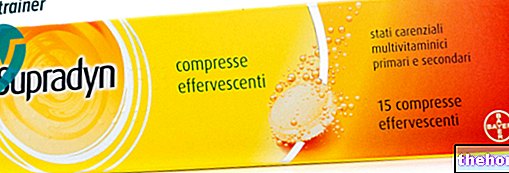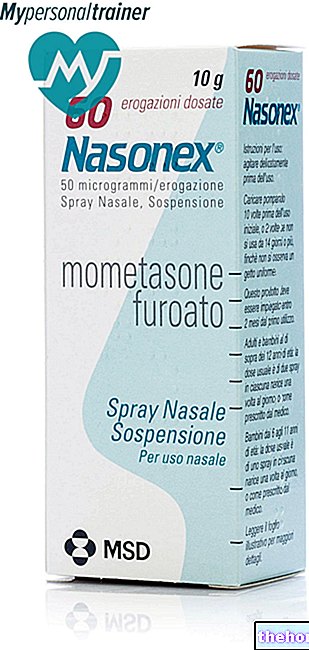Active ingredients: Midodrina
GUTRON 2.5mg tablets
GUTRON 2.5 mg / ml oral drops, solution
GUTRON 5 mg / 2 ml solution for injection
Indications Why is Gutron used? What is it for?
PHARMACOTHERAPEUTIC CATEGORY
Gutron is a preparation with anti-hypotensive activity containing the active ingredient midodrine hydrochloride which, by enhancing the activity of the sympathetic autonomic nervous system (α-sympathomimetic action), causes venous and arteriolar constriction at the peripheral level with a consequent increase in blood pressure. arterial.
THERAPEUTIC INDICATIONS
Orthostatic dysregulation (sympathetic, asympathetic) in the diagnosis of:
- hypotensive-asthenic syndrome; essential hypotension; orthostatic hypotension; post-operative, post-infectious, post-partum hypotensive states; hypotension on a climatic basis;
- hypotension following treatment with psychotropic drugs.
Contraindications When Gutron should not be used
Arterial hypertension, heart disease, pheochromocytoma, vascular diseases of an obliterating or spastic nature, severe coronary artery disease, advanced vascular sclerosis, closed angle glaucoma, prostatic hypertrophy with urine retention, mechanical obstacles to urinary outflow, thyrotoxicosis. Individual ascertained hypersensitivity to the product.
Precautions for use What you need to know before taking Gutron
During pregnancy use only in case of absolute and ascertained necessity and under direct medical supervision. In diabetic patients it is advisable to carry out a more frequent determination of glycemic values. During prolonged treatments, periodic monitoring of renal function is recommended.
Interactions Which drugs or foods can modify the effect of Gutron
The vasopressor effect of Gutron can be enhanced by mono-amino-oxidase inhibitors (MAOIs), the simultaneous administration of which should therefore be avoided.
Warnings It is important to know that:
For those who carry out sporting activities: the use of the drug without therapeutic necessity constitutes doping and can in any case determine positive anti-doping tests.
For those who carry out sporting activities, the use of medicines containing ethyl alcohol can determine positive anti-doping tests, in relation to the alcohol concentration limits indicated by some sports federations.
EFFECTS ON THE ABILITY TO DRIVE AND ON THE USE OF MACHINES
Nothing in particular to report.
Dosage and method of use How to use Gutron: Dosage
The dosage of Gutron must be established individually in relation to the different response of the patient. It is advisable to start treatment with dosages proportional to the entity of the symptoms, subsequently modifying them according to the therapeutic response.
In the mild and medium forms, the indicative dosage is 10-20 drops or 1/2 - 1 tablet up to 3 times a day. The drops can be taken diluted in water or on a sugar cube.
In the most severe hypotensive states and in the hypotension following treatment with psychotropic drugs: 2.5 - 5 mg (1-2 tablets or 1 ampoule) up to 3 times a day. The ampoules can be administered intramuscularly, slowly intravenously, possibly diluted in the usual solutions for infusion.
Overdose What to do if you have taken too much Gutron
The possible occurrence of reflex bradycardia (excessive slowing of the heartbeat), an excessive increase in blood pressure and other symptoms of overdose (see side effects) can be quickly controlled by the doctor by administering atropine at the usual therapeutic doses and / or α-blocking drugs.
Side Effects What are the side effects of Gutron
Dizziness or vertigo and tingling head and trunk may occur in some patients. The possible onset of these phenomena, with oral administration, occurs after about 1-2 hours from the intake, and can persist for about 3-5 hours.
Excessive doses of Gutron can cause pilomotor reactions (goose skin), especially in the scalp, feeling of cold, increased urge to urinate, headache, palpitations and sometimes reflex bradycardias. brochure.
Expiry and Retention
For the expiry date, refer to the one shown on the package. Warning: do not use the medicine after the expiry date indicated on the package. Store the medicine in a dry place.
Composition and pharmaceutical form
COMPOSITION
2.5 mg tablets
Each 0.130 g tablet contains:
Active ingredient: 2.5 mg Midodrine hydrochloride
Excipients: Starch, microcrystalline cellulose, silicon dioxide, talc, magnesium stearate.
2.5 mg / ml oral drops, solution
Each 100 ml of solution contain:
Active ingredient: Midodrine hydrochloride g 0.25
Excipients: 95% ethyl alcohol, purified water.
5 mg / 2 ml solution for injection
Each 2ml vial contains:
Active ingredient: Midodrine hydrochloride 5 mg
Excipients: Sodium chloride, Propylene glycol, Water for injections.
PHARMACEUTICAL FORM AND CONTENT
30 divisible tablets of 0.130 g bottle of 30 ml 6 ampoules of 2 ml
Source Package Leaflet: AIFA (Italian Medicines Agency). Content published in January 2016. The information present may not be up-to-date.
To have access to the most up-to-date version, it is advisable to access the AIFA (Italian Medicines Agency) website. Disclaimer and useful information.
01.0 NAME OF THE MEDICINAL PRODUCT
GUTRON
02.0 QUALITATIVE AND QUANTITATIVE COMPOSITION
2.5 mg / ml oral drops, solution
Each 100 ml of solution contain:
Midodrine hydrochloride g 0.25
2.5 mg tablets
Each 0.130 g tablet contains:
Midodrine hydrochloride 2.5 mg
5 mg / 2 ml solution for injection
Each 2ml vial contains:
Midodrine hydrochloride 5 mg
03.0 PHARMACEUTICAL FORM
Oral drops, solution
Divisible tablets
Vials
04.0 CLINICAL INFORMATION
04.1 Therapeutic indications
Orthostatic dysregulation (sympathetic, asympathetic) in the diagnosis of:
hypotensive-asthenic syndrome; essential hypotension; orthostatic hypotension; post-operative, post-infectious, post-partum hypotensive states; hypotension on a climatic basis;
hypotension following treatment with psychotropic drugs.
04.2 Posology and method of administration
The dosage of Gutron must be established individually in relation to the different reactivity of the autonomic nervous system and the vasotonic situation of the patient.
It is advisable to start treatment with dosages proportional to the entity of the symptoms, subsequently modifying them according to the therapeutic response.
In the mild and medium forms, the indicative dosage is 10-20 drops or 1 / 2-1 tablet up to three times a day. The drops can be taken diluted in water, or on a sugar cube.
In the most severe hypotensive states and in the hypotension following treatment with psychotropic drugs: 2.5-5 mg (1-2 tablets or 1 ampoule) up to three times a day. The ampoule formulation can be administered intramuscularly, slowly intravenously, possibly diluted in the usual solutions for infusion.
04.3 Contraindications
Arterial hypertension, pheochromocytoma, obliterating and spastic vasculopathies, severe coronary artery disease, advanced vascular sclerosis, closed angle glaucoma, prostatic hypertrophy with urine retention, mechanical obstacles to urinary outflow, thyrotoxicosis. Individual ascertained hypersensitivity to the product.
04.4 Special warnings and appropriate precautions for use
The possible occurrence of reflex bradycardia and other symptoms of overdose, such as an excessive increase in blood pressure, can be rapidly controlled by the administration of atropine at the usual therapeutic doses and / or blocking drugs.
The product, even if not through a stimulation of the b-receptors, can indirectly affect cardiac function due to the greater effort due to the increase in venous return and peripheral resistance.
During prolonged treatments, periodic monitoring of renal function is recommended.
In diabetic patients it is advisable to carry out a more frequent determination of glycemic values.
Keep out of reach of children.
04.5 Interactions with other medicinal products and other forms of interaction
The vasopressor effect of the product can be enhanced by I.M.A.O. drugs, the simultaneous administration of which must therefore be avoided.
04.6 Pregnancy and lactation
The product can be used during pregnancy only in conditions of absolute and ascertained necessity.
04.7 Effects on ability to drive and use machines
Nothing in particular to report.
04.8 Undesirable effects
Some patients may experience dizziness or dizziness and tingling in the head and trunk. The possible onset of these phenomena, with oral administration, occurs after about 1 or 2 hours from intake, and can persist for about 3-5 hours. Excessive doses of Gutron can cause pilomotor reactions (goose skin), especially at scalp, feeling of cold, increased urge to urinate, headache, palpitations and sometimes reflex bradycardias.
04.9 Overdose
See points 4.4 and 4.8.
05.0 PHARMACOLOGICAL PROPERTIES
05.1 Pharmacodynamic properties
Midodrine, structurally constituted by the union of two well-defined molecular entities (a catecholamine, 1- (2,5-dimethoxyphenyl) -2-aminoethanol and an amino acid, glycine), is particularly characterized by the property of inducing a peripheral level an increase in venous and arteriolar tone which results in a progressive increase in venous return to the heart and a consequent increase in blood pressure values.
The peculiar pharmacodynamic characteristic of midodrine consists in the fact that it exerts a direct and selective stimulating action on peripheral a-adrenergic receptors, which excludes possible interference on b-adrenergic receptors, the stimulation of which would cause cardiac, bronchial and metabolic effects.
05.2 Pharmacokinetic properties
The midodrine molecule is not active by itself, but only after metabolic transformation. Pharmacokinetic investigations, performed with tritium-labeled midodrine (3H-midodrine), credit midodrine as a "transport form" of its pharmacologically active metabolite, 1- (2,5-dimethoxyphenyl) -2-aminoethanol, which it is released in the organism by enzymatic splitting of the glycine residue. This prevents the rapid metabolization of the preparation in the enterohepatic circulation and guarantees a high bioavailability also for oral administration.
After about 25 minutes the 3H-midodrine is completely absorbed.
The pharmacologically active metabolite is released into the circulation by enzymatic cleavage, reaching the highest plasma level after about one hour.
The slow and gradual release of the active principle determines a progressive and prolonged effect up to about the twelfth hour.
Elimination of 3H-midodrine and its metabolites occurs almost exclusively via the urine.
The major elimination product after intravenous administration is its pharmacologically active metabolite.
During the 8 hours following the injection, this elimination is 54%, reaching 90% after about 24 hours.
05.3 Preclinical safety data
From toxicity studies carried out on various animal species, it appears that midodrine has poor acute toxicity and good tolerability following medium and long-term administration.
It also does not affect fertility, gestation and fetal and neonatal development; finally, it does not exert teratogenic effects.
06.0 PHARMACEUTICAL INFORMATION
06.1 Excipients
2.5 mg / ml oral drops, solution
95% ethyl alcohol, purified water.
2.5 mg tablets
Starch, microcrystalline cellulose, silicon dioxide, talc, magnesium stearate.
5 mg / 2 ml solution for injection
Sodium chloride, Propylene glycol, Water for injections.
06.2 Incompatibility
None.
06.3 Period of validity
36 months
06.4 Special precautions for storage
2.5 mg tablets
To be kept in a dry place
To be kept away from light
2.5 mg / ml oral drops, solution and 5 mg / 2 ml solution for injection
To be kept away from light
06.5 Nature of the immediate packaging and contents of the package
2.5 mg tablets
Blisters thermoformed from opaque rigid PVC tape, sealed by heat sealing with aluminum tape filmed with heat-sealing resin for PVC, packaged in a lithographed cardboard box.
Box of 30 divisible tablets
2.5 mg / ml oral drops, solution
Amber glass bottle, Class III, containing 30 ml of hydroalcoholic solution, with incorporated dropper and sealed with a screw cap fitted with a sealing gasket, packed in a lithographed cardboard box.
30 ml dropper vial
5 mg / 2 ml solution for injection
Colorless neutral glass vials, type I, meeting the tests required by the F.U. VIII Ed., Vol. I, p. 457 for containers intended to store injectable solutions, packaged in a lithographed cardboard box.
Box of 6 vials of 2 ml
06.6 Instructions for use and handling
Not relevant.
07.0 MARKETING AUTHORIZATION HOLDER
LUSOFARMACO
Luso Farmaco Institute of Italy S.p.A.
Via W. Tobagi, 8 - Peschiera Borromeo (MI)
Under license from Nycomed Austria GmbH
08.0 MARKETING AUTHORIZATION NUMBER
2.5 mg tablets: 024519011
2.5 mg / ml oral drops, solution: 024519023
5 mg / 2 ml solution for injection: 024519035
09.0 DATE OF FIRST AUTHORIZATION OR RENEWAL OF THE AUTHORIZATION
7.12.1981 / 1.06.2005
10.0 DATE OF REVISION OF THE TEXT
February 2010




























